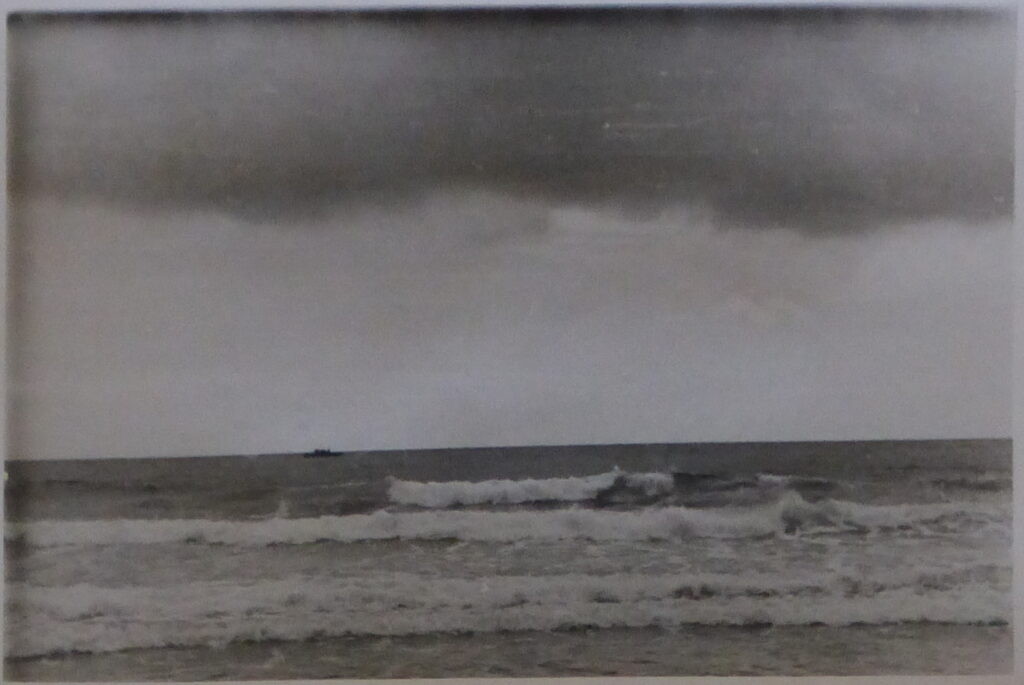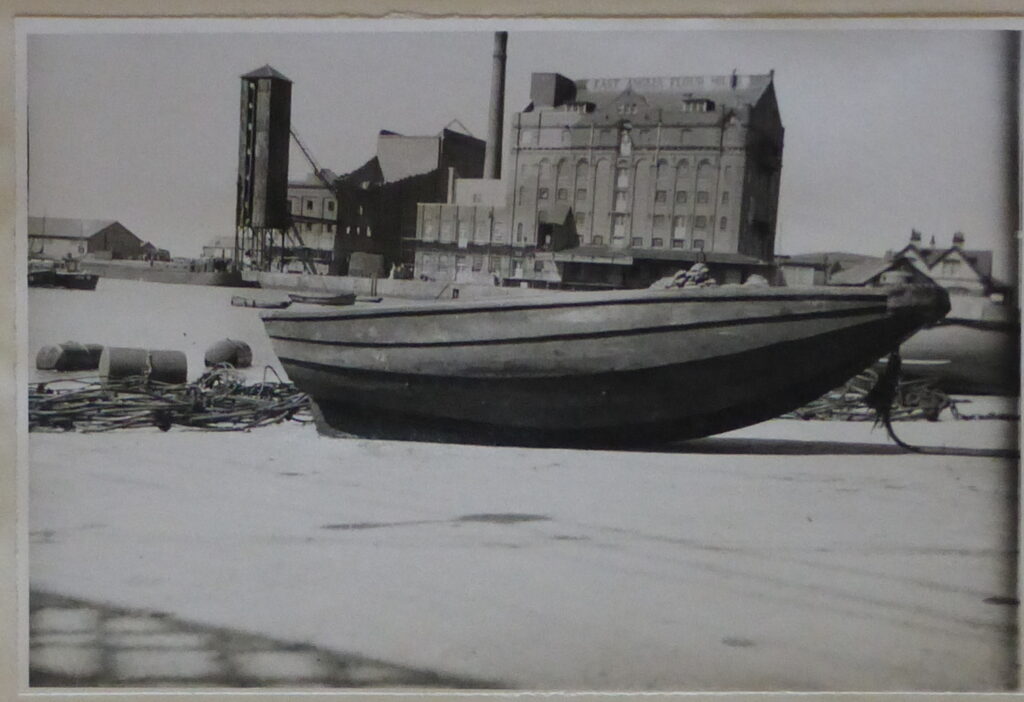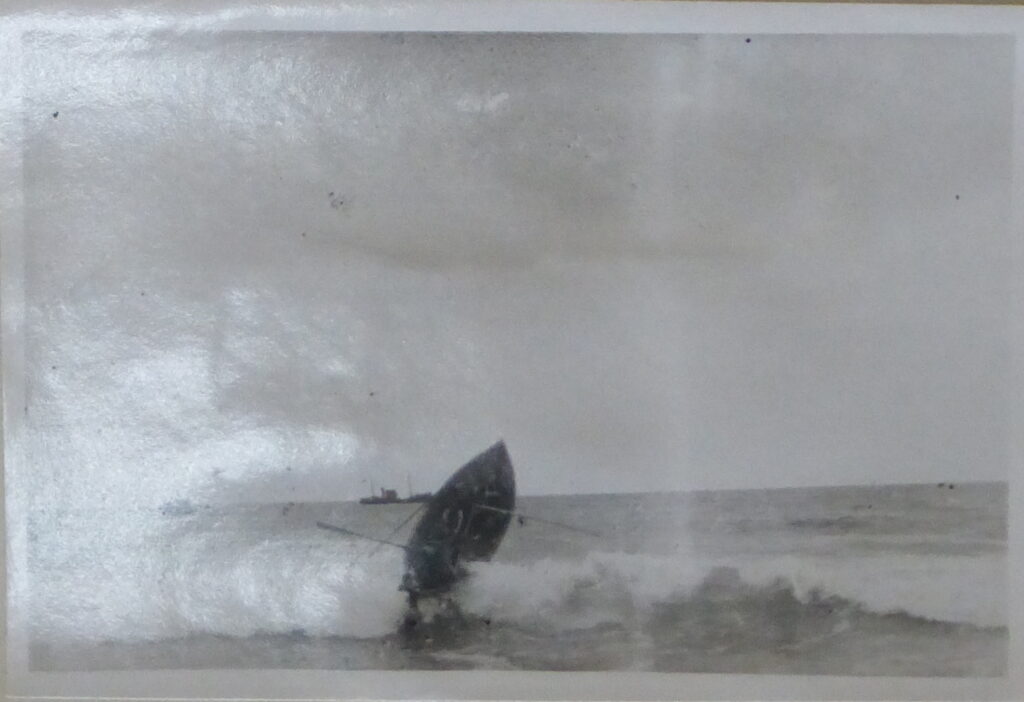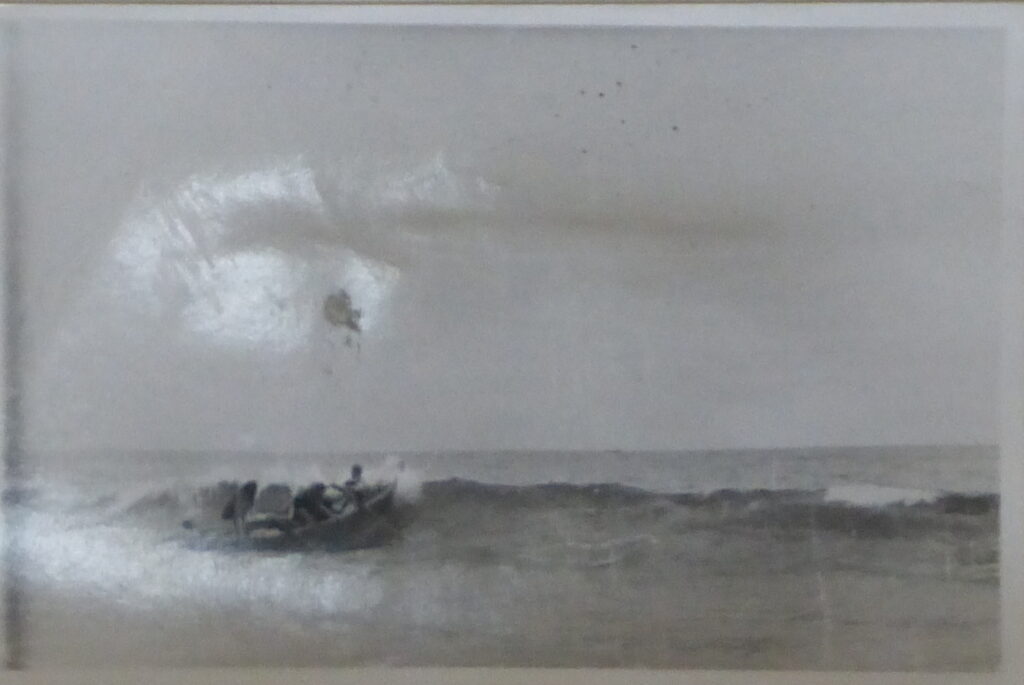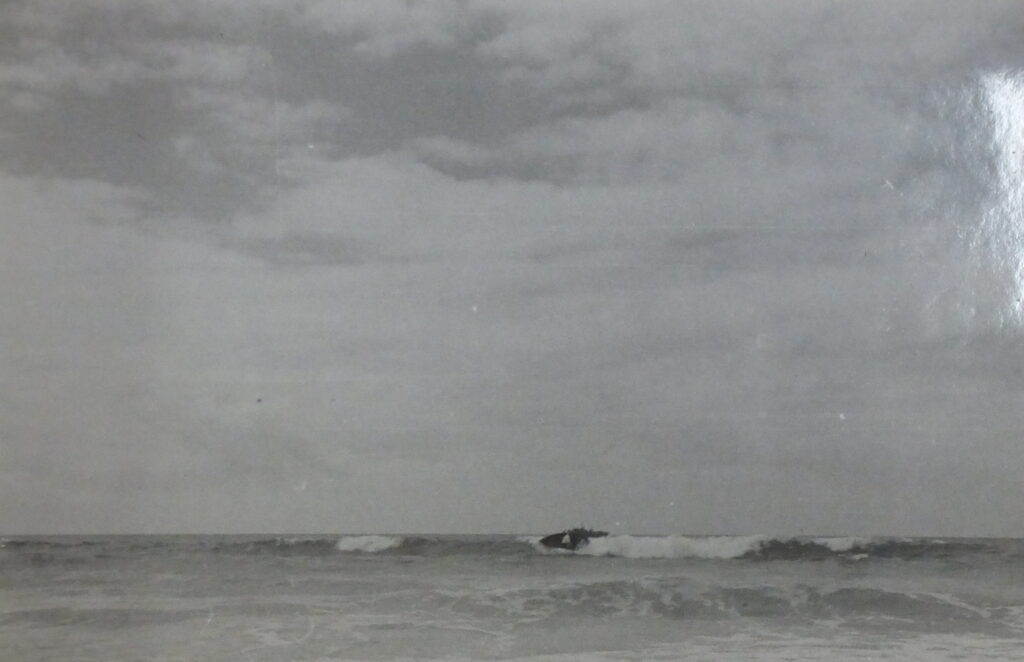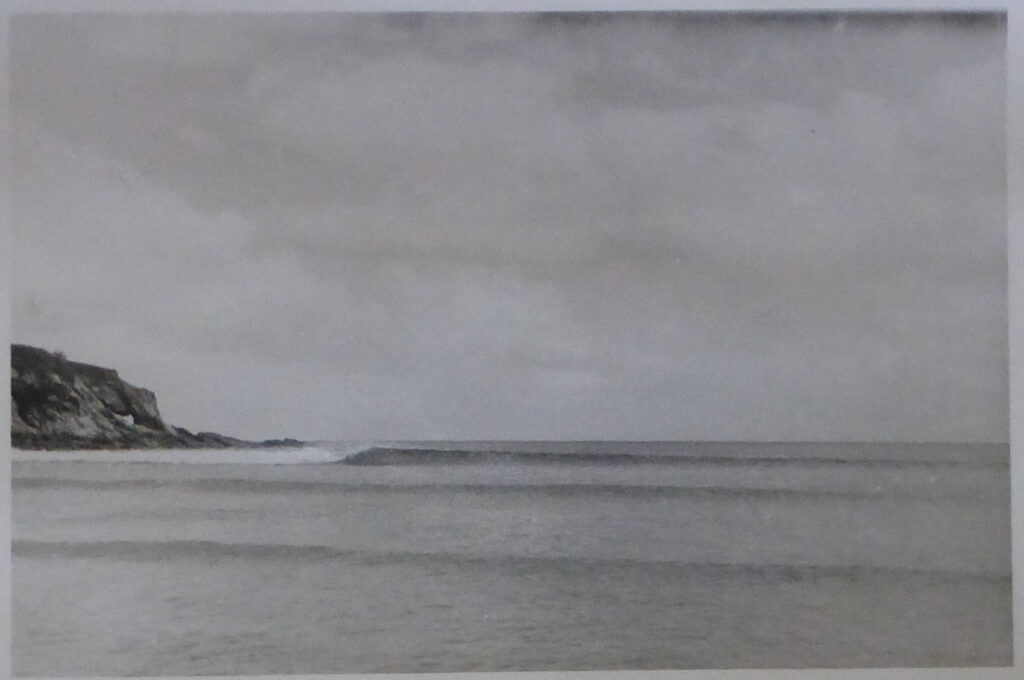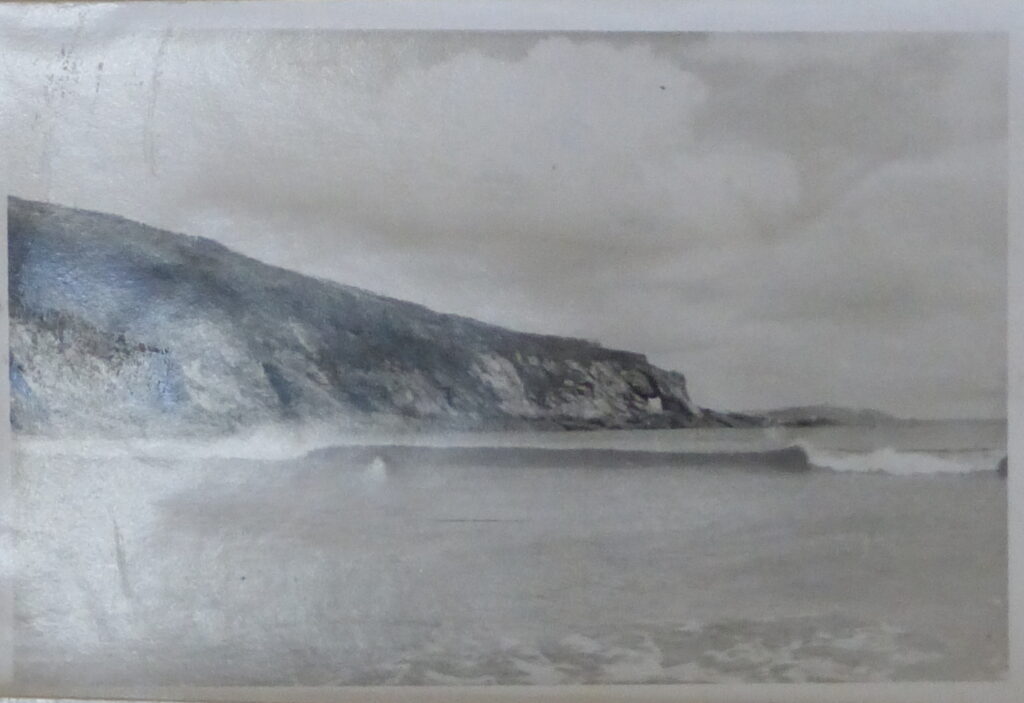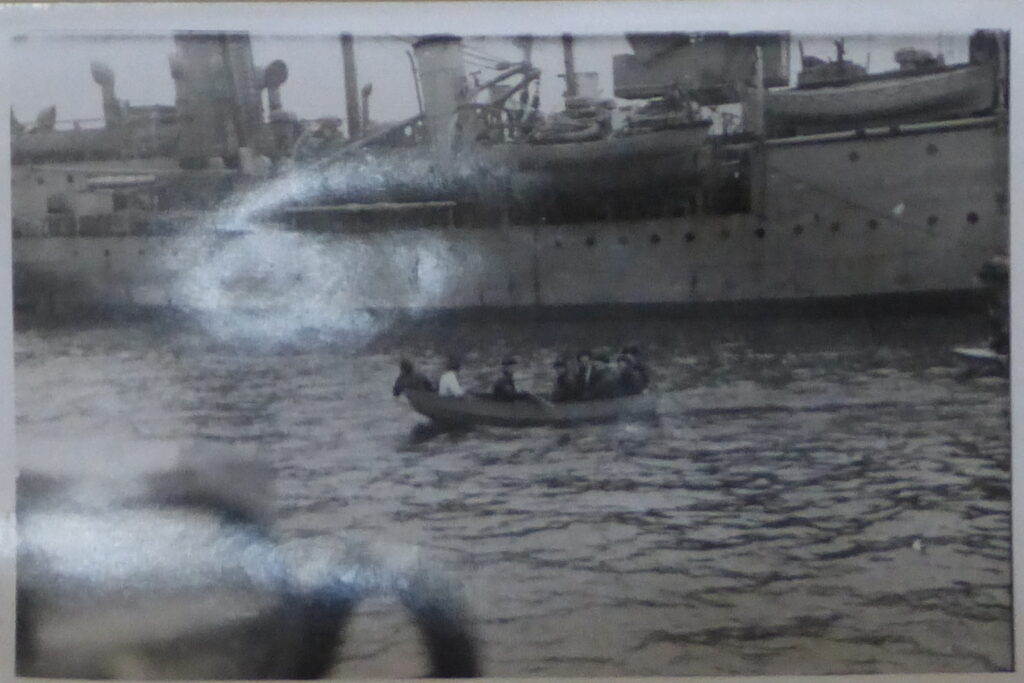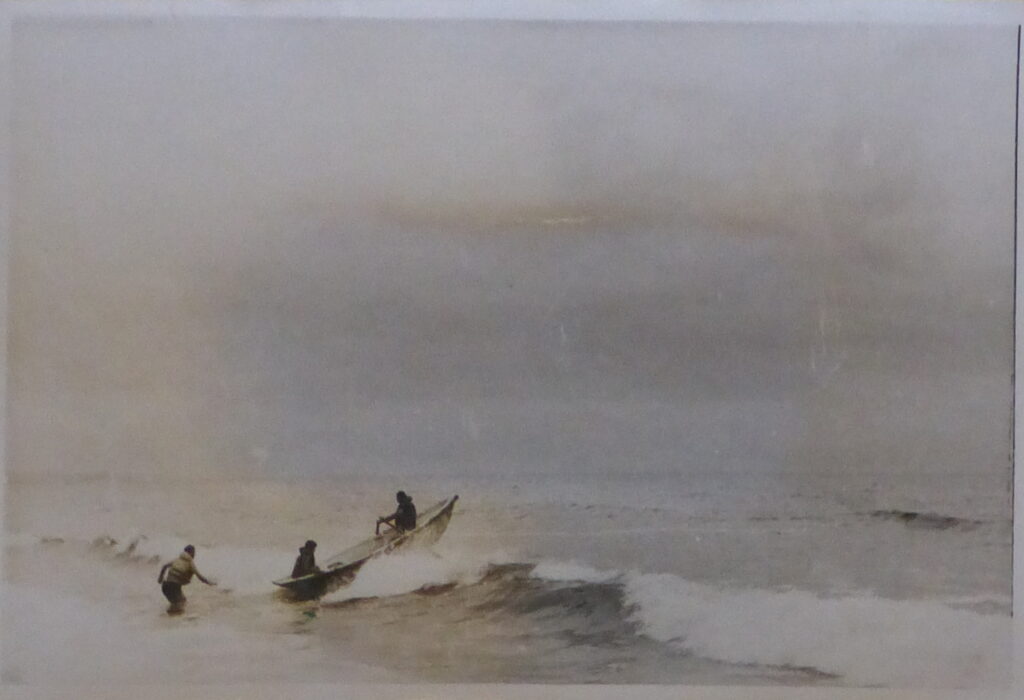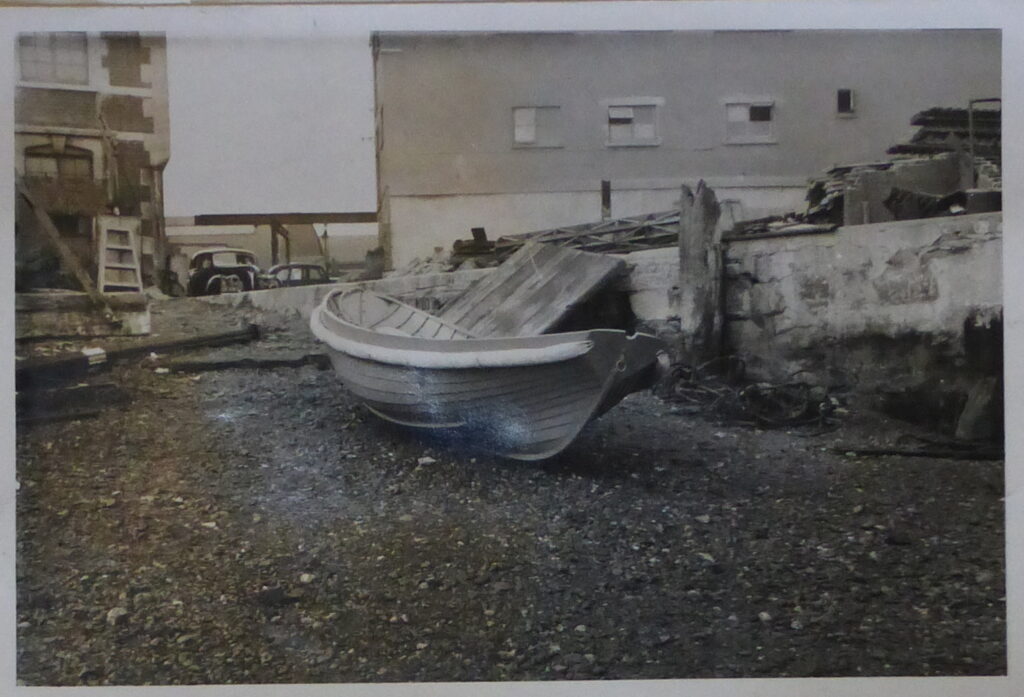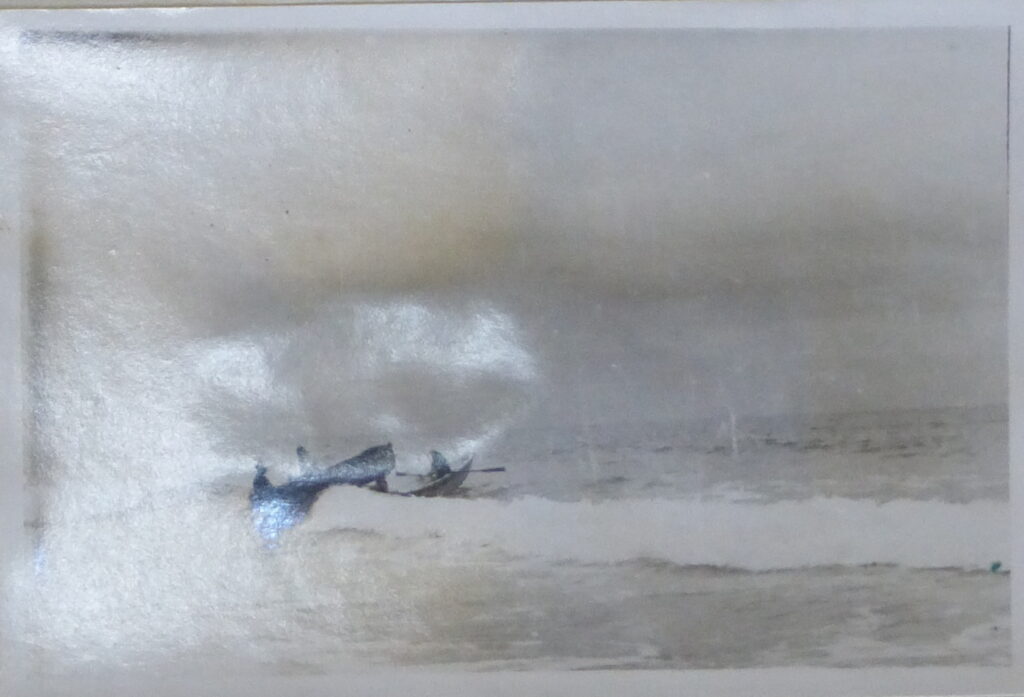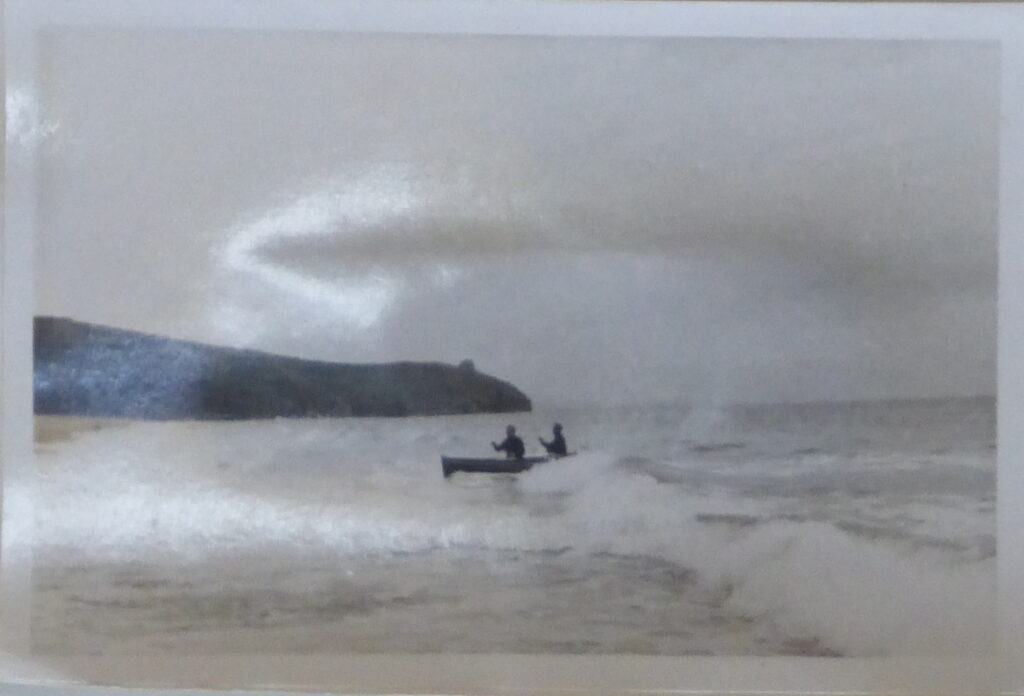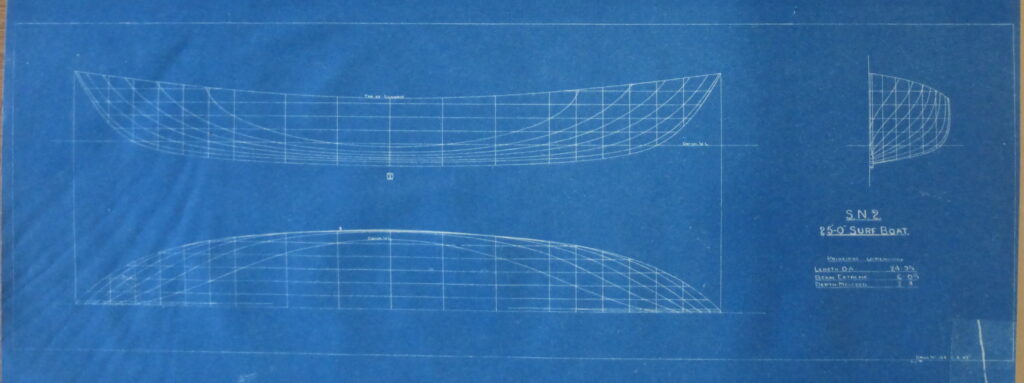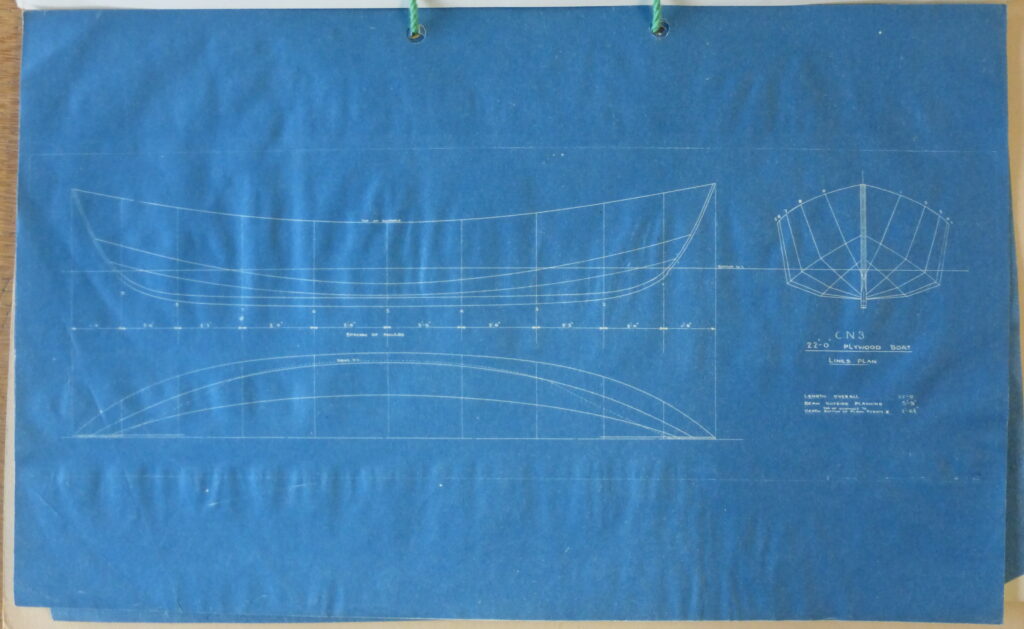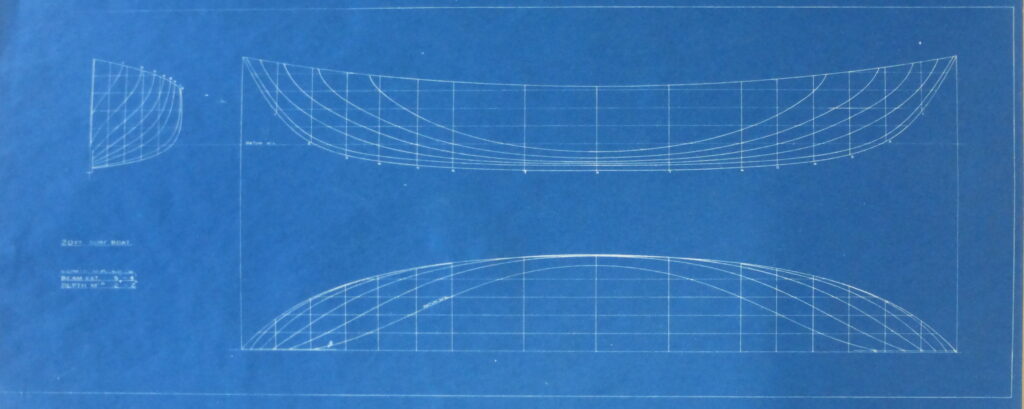This is a transcript of a report co-authored by Lt Nigel Warington Smyth and Lt Whalley after Operation SLIDERULE designed to test a series of boats suitable for landing through surf. 1
A further test was carried out in March 1943, entitled Operation PLANIMETER. The report of this Is similar in many respects to this one, but with additional images.
Surf Landing
Problem
To find a method of landing with small boats through surf on shallow beaches.
Scope of Enquiry
2 The length of boat was limited by the carrying capacity of an ML,2 the fact that it should not look conspicuous when stowed on deck, and that special hoisting and lowering gear was undesirable. The maximum length and weight for the particular purpose was decided to be 14 feet and 300 lbs. An 18ft surf boat has been tested and MGB 501 (since lost at Sea) was fitted to carry one. A 25ft surf boat has also been designed and is at present building.3
History of Enquiry
3 A preliminary investigation of literary sources and discussion with fishermen and lifeboat designers showed that no information was available about small surf boats. It was the expressed opinion of the RNLI and fishermen that no boat shorter than 30, or at least 25, feet could be regarded as ‘a reasonable proposition’ for surf work.
4 Messrs Camper & Nicholson of Gosport had independently carried out an investigation on behalf of Major March-Phillips and in July 1941 produced an 18ft hard-chine dory-type surf boat (CN 1), based on lines of large West-African surf boats. Plywood construction imposed the series of hard chines – otherwise the lines were strikingly similar to a 30ft lifeboat designed by RNLI for pulling. A 22ft version of this boat (CN 3) was later produced by Camper & Nicholson for Major March-Phillips, but its performance and history are not known.
5 CN 1 proved to be too large and heavy for the work envisaged. The investigation of a suitable 14ft boat was therefore continued.
6 It was known that a species of pram dinghy was used by lifeguards in surf off the Dutch beaches. One of these boats was discovered in an East Coast port, but when its measurements were taken, the midship section was found to be dangerously weak. The improvement of lines for stability involved either lengthening the boat to produce the characteristic bow or cutting off the bow in order to keep the boat to the required length. The second course was adopted and a 13’ 6” boat (PD 1) of unorthodox appearance and unparalleled sea-worthiness emerged from Camper & Nicholson’s yard, contrary to the dictates of their professional sensibility.
7 Camper & Nicholson then designed a 14ft version of CN 1 but building was postponed until further information from surf trials was available and the design was finally abandoned.
8 Operation SLIDERULE was designed to test CN 1, PD 1 and two ordinary boat dinghies. A single-ended dory (BR 1) was also provided for trial from another source. The experiences gained in Operation SLIDERULE were embodied in a new 14ft design, SN 1, one of which type is now in use, and a 25ft boat, SN 2, now building.
Conclusions from Operation SLIDERULE
9 Boats tested: CN 1, PD 1, BR 1, one 10ft dinghy, one 11ft Scotch dinghy.
10 Propulsion
a) Oars: The length of oars is important. The blades should be narrow and long. A long sweep is essential except in light surf. Rowing is the most economical mode of propulsion in respect of man-power (see (d) below on rowlocks).
b) Paddles: A quiet but extravagant mode of propulsion. Two men with paddles could not develop sufficient speed or manoeuvrability even in the 12ft dinghies. The shape of a small surf boat does not lend itself to paddling. Paddles have definite advantages – no rowlocks needed, ease in adjusting work in rough water, power quickly available. But a high degree of co-ordination is needed and the best attitude for paddling is a relatively unstable one. When paddles are used they should be light in construction, long and full-bladed.
c) Punt Poles: Very effective for getting a boat through the first critical phase of launching. Power can be quickly and positively applied, but a punter finds it difficult to maintain the constant watch ahead that surf work requires and even when battens are provided on the floor he is likely to lose his balance. The results obtained by punting, however, well repay the skill required to carry it out with impunity.
d) Rowlocks: A critical problem not yet solved. In surf, oars are frequently knocked out of crutches and difficulty is experienced in replacing them. No form of rowlock which secures the oar warrants the risk of injuries to a boat’s crew when capsizing. The answer is probably to be found in deeply cut rowlocks set into the gunwale, possibly with some quick release retaining device.
11 Handling small boats in surf
a) Surf-riding is effortless, fast and exhilarating, but correspondingly dangerous. Most boats when surf-riding sooner or later take a sudden sheer and when this happens disaster follows with inexorable certitude and swiftness. The boat is carried on the forward slope of the wave and gradually slides back through the crest to the after slope. It is while the boat is on the forward slope that the sheer occurs. The crest then crashed against the weather quarter and side and capsizes the boat in the manner of Fig 1.4 Throughout the critical period when the boat is being carried on the forward slope of the breaker, it is impossible to reach or grip the water with the sweep and, at the speeds experienced in surf-riding, oars are generally knocked out of the rowlocks is an attempt is made to control the boat with them.
b) The safest approach is bow to sea, meeting each breaker squarely, pulling gently to seaward through each wave to check any tendency the boat may have to surf-ride. A double-ender should be rowed in stern first, so that the steering sweep has maximum grip before and at the moment of impact, and so that the coxswain can con his boat, meeting each wave squarely.
c) In heavy surf it will be found impossible to prevent the boat from surf-riding. A small drogue should then be used, the drogue being tripped after each wave has passed. A drogue also helps to rectify any failure to keep the boat accurately head to sea.
d) The kedge suggest itself as a useful check in the approach and as a purchase to haul the boat off the beach. It has, however, proved to be dangerous and impracticable. There is generally a current or breeze running along the beach, with the result that the warp is soon found to be leading off one bow or the other. It is then impossible in moderate surf to keep the boat head to sea and disaster will surely follow.
e) In launching, one man must be on the oars and the passengers inboard at the earliest possible moment. The boat is then man-handled out until well afloat and under command of the oars. Once afloat a punt pole makes it possible to pass quickly through the heaviest breakers.
12 Factors affecting the Design of Surf Boats
The critical moment is when a wave breaks and it is to survive that critical instant that a surf boat must be designed. Until it breaks, a wave is merely an undulation in the water, the motion of the water being almost entirely vertical. As the wave proceeds into shoal water it is tripped at the foot, the crest advances, forming an arch higher than the initial amplitude of the wave, until finally the forward impulse of the crest carries the water beyond the support of the arch. A weight of water is then impelled downward and forward at considerable speed, a formidable weight sufficient to swamp or smash a small boat if the boat cannot rise through it. There follows the rapid forward movement of a smother of broken unbuoyant water. A dinghy of normal design is frequently engulfed by this water owing to its inability to lift itself.
13 A preliminary consideration of hull form suggests that a fine entry will help a boat to break through waves. But, as has been shown, the danger is from water in vertical as well as horizontal motion; the boat must be able both to cut through and to rise quickly above breaking water. This can be achieved by providing a high bow, plenty of overhand and flare.
14 A problem peculiar to small boats now appears. If the buoyancy forward is very great the boat will rise instantly to a small wave and perpendicularly to a moderate wave. A limiting point is soon reached, where the lively vertical motion of the bows makes control extremely difficult and the stability of the crew uncertain. This difficulty can only be surmounted by length – hence the surfmen’s assertion that 25-30 feet is the minimum length for reliable surf work. Buoyancy forward must be balanced by buoyancy aft and the double-ender becomes necessary for technical reasons alone. (Note: In respect of buoyancy PD 1 is virtually double-ended). A small boat (say 14ft long) may have an excellent bow, but with a small buoyancy and low freeboard aft it will be pooped by a moderate wave, and even with bow to sea a breaking wave will lift the bow and depress the stern until the boat fills and founders by the stern. This point was fully substantiated by the performance in trials of BR 1.
15 Draft, freeboard and height of overhang are all dictated by surf conditions. The draft must be as small as possible to avoid the uncommon mischance of the boat’s forefoot grounding in shallow water while travelling at speed. The freeboard must not be made so high as to make rowing an awkward and tiring operation. In any case it has been found that water rarely enters the boat amidships. The height of overhang is affected by the fact that the launching party must clamber into the boat in comparatively deep water. A pointed, flared end is awkward in this respect but the operation can be facilitated by fitting a foothold on either side.
16 The principles outlined have been incorporated in the two boats SN 1 (14ft) and SN 2 (25ft) – a fine forefoot, with plenty of reserve buoyancy above in the first few feet of length. The top flare of SN 1 and SN 2 and the general form of PD 1’s bow present a planning surface to the fast-moving, unbuoyant water of the broken crest. The boat’s head in this way lifts immediately even if the buoyancy of the boat is too slow in coming into operation.
17 An interesting feature of the design thus evolved is the stability and carrying capacity of the boats. The initial stability of SN 1 when lightly laden is less than PD 1 but it rapidly improves as the boat is loaded. The same design in a 16ft boat would be more stable, as there would be an area of maximum breadth on the waterline more than 2ft in length as opposed to the few inches in SN 1. Unlike BR 1 none of these boats becomes crank when laden.
Dimensions and Capacity of Surf Boats
18 Following are principal dimensions of the boats under discussion. Capacities at Datum WL are arbitrary, being calculated for the datum waterline of the drawings. All capacities with 1ft freeboard are calculated from the displacement curves.
| CN 1 | PD 1 | SN 1 | SN 2 | |
| Construct | Plywood | Clinker | Clinker | Clinker |
| Type | Hard-chine West African | Dutch pram dinghy | New design | New design |
| Length overall | 18’ 0” | 13’ 6” | 14’ 3” | 24’ 9½” |
| Beam | 5’ 8” | 5’ 2” | 5’ 0” | 6’ 0½” |
| Depth | 2’ 4½” | 2’ 1” | 2’ 0” | 2’ 4” |
| Weight | 4½ cwt | 280 lbs | 2 cwt (approx.) | 7 cwt (approx.) |
| Capacity at DWL | 3 men (500 lbs) | 3 men (565 lbs) | 2 men (300 lbs) | 5 men (900 lbs) |
| Capacity with 1ft freeboard | 1 ton + 5 men | ½ ton + 4 men | ½ ton + 3 men | 3 tons |
Performance of individual boats
19 CN 1
This boat has been tested almost to the limit but was never capsized or filled. In the last launching on the evening of 9.8.42 she was several times thrown into the vertical (see Fig 3, taken before she had reached the top of her swing). This is the boat’s only weakness; for, although dry and buoyant (see Fig 4), her lift was too quick, with the result that she became ‘uninhabitable’ before her other qualities were tested to the limit. It is noteworthy that he buoyancy astern was sufficient to prevent her filling in the vertical position. And that her recovery was positive without being unduly abrupt. CN 1 can probably survive surf in any weather in which CF craft can be sailed, provided a heavy swell has not developed. This boat was tested on an exposed shallow beach with an on-shore wind of Force 4 (see Fig 5). This boat can be handled adequately by a coxswain and two men, and in bad conditions by a coxswain and four men.
20 PD 1 (Fig 8)
On paper this boat looks too bluff for pulling through a heavy sea. It was thought that a breaking sea, striking the flat surface of the upper bow, would stop her dead. In trials, however, she proved easy to pull and lifted so quickly to a wave that she was not in fact stopped, while her great buoyancy aft and slight tumblehome gave her a quick recovery. She was once capsized while surf-riding by her forefoot grounding at speed. This was largely due to careless distribution of weight forward. She was able to negotiate as heavy surf as CN 1 and when last launched on the evening of 9.9.42 proceeded unspectacularly to seaward with five men aboard. She can adequately be handled by a coxswain and one man, and easily by a coxswain and two men.
(The original Dutch pram dinghy is shown in Fig 2).
21 BR 1
No lines of this boat are available but her features are clearly shown in Fig 9. Her bow was lively and dry but the boat is rendered useless for surf-work by her low unbuoyant stern. On several occasions she was pooped by a following sea, or filled by having her stern depressed by a head-on wave. In surf-riding she invariably took a wild sheer, due possibly to her hard chine. When loaded with more than three men she became unstable and clumsy to row.
22 Dinghies
One transom-sterned dinghy (Fig 1) and a Scotch dinghy (Fig 12) were tested. Both were good examples of yacht dinghies, carefully selected from a large number of boats. Their lack of flare and freeboard makes them totally unsuitable for work on a lee shore. Even in modest rill-waves (figs 6 & 7) the life of these I boats is short and precarious.
23 SN 1 (Fig 10)
This boat, recently completed, has not been fully tested. It is expected to react to surf in much the same manner as PD 1 with the added advantage of her markedly hollow ends and the fact of being double-ended. It is considered that if a 16 or 18 foot boat were permissible the SN 1 bows together with the increased midships stability would make an admirable surf boat. Judging by lines alone, the designs of SN1 look extreme, but when the salient features are produced in a 25ft boat (SN 2) the effect is please and almost orthodox.
24 Lines of CN 1, PD 1, SN 1 and SN 2 are attached.
15.10.42
